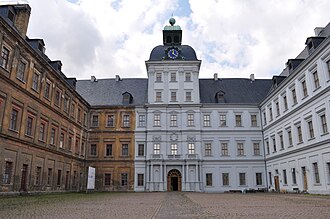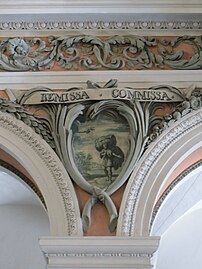Neu-Augustusburg Castle
The Weißenfelser Schloss Neu-Augustusburg in Saxony-Anhalt was from 1680 to 1746 the residence of the Dukes of Saxony-Weißenfels , a secondary school of the Saxon Wettins .
The well-preserved early baroque building with its important St. Trinitatis Castle Church is a nationally valuable cultural monument .
Today the castle houses the Weißenfels Museum . In addition to an exhibition on the shoe trade, which goes back to the GDR Shoe Museum, which has been located there since 1964, a newly designed exhibition on the Duchy of Saxony-Weißenfels has also been shown since 2007.
Construction and meaning
The foundation stone was laid on July 25, 1660 by August, Archbishop of Magdeburg , who, thanks to the will of his father Johann Georg I of Saxony, had also been the first duke of the Saxon secondary education in Saxony-Weißenfels since 1657 and the duchy from his episcopal new residence in Halle managed.
The castle was built in the old castle complex that was razed by the Swedes in 1644 during the Thirty Years War . At the end of the war and the associated Peace of Westphalia in 1648 , the Electorate of Brandenburg acquired the claim to the Duchy of Magdeburg , the secularized property of the Archbishopric of Magdeburg . The transition from Magdeburg to Brandenburg was not to take place until Duke August died as the last administrator of the archbishopric. It is therefore assumed that Duke August had Neu-Augustusburg built for his son with this knowledge, who after his death was restricted to the Sachsen-Weißenfels secondary school.
Son Johann Adolf I von Sachsen-Weißenfels moved into the unfinished castle in 1680 after the death of his father as the new and first duke and completed it over the next 14 years. The builders were Johann Moritz Richter and his son of the same name . With this building, both created one of the largest early baroque palace complexes in Central Germany .
Until the dissolution of the duchy in 1746 resided at the castle:
- 1680–1697 Johann Adolf I of Saxony-Weissenfels
- 1697–1712 Johann Georg von Sachsen-Weißenfels
- 1712–1736 Christian von Sachsen-Weißenfels
- 1736–1746 Johann Adolf II of Saxony-Weissenfels
The client from 1660, Duke August, Archbishop of Magdeburg
Johann Adolf I. von Sachsen-Weißenfels , first duke to reside at the castle
The castle developed into a cultural center that attracted important artists such as Johann Beer , Johann Philipp Krieger , Georg Philipp Telemann and Friederike Caroline Neuber .
It was here that Duke Johann Adolf I von Sachsen-Weißenfels discovered the musical talent of the young Georg Friedrich when he asked his personal physician Georg Handel to let his son play the organ with him in the castle church. Johann Sebastian Bach composed the cantata What I like is just the lively Jagd BWV 208 (Jagdkantata) , which premiered in 1713 in honor of the Duke in Weissenfels (today Hotel Jägerhof) for Duke Christian von Sachsen-Weißenfels . His cantata Escape, Disappear, Escape, Her Worries BWV 249a (Shepherd's Cantata ) was played on the Duke's birthday in 1725 at Neu-Augustusburg Castle. He composed his Toccata and Fugue in F major BWV 540 for the organ of the castle church .
After the Weißenfels ducal house died out in 1746, the castle initially returned to the Electorate of Saxony and was rarely inhabited. From 1815 it belonged to Prussia and was converted into barracks for a battalion of the 1st Thuringian Infantry Regiment No. 31 in Erfurt . As such, it was used by the army as a non-commissioned school until 1920, then by the police. From March to August 1933 the castle served as a "prisoner assembly camp" for political prisoners. After 1945, refugees found accommodation there, after which a technical school for local museums and the GDR shoe museum were established in the castle. In 1993 it was handed over to the city of Weißenfels for administration. Since then, the building has been restored in stages.
Today the Weissenfels Museum is located in the castle building . In addition to an exhibition on the shoe trade, which essentially goes back to the conception of the GDR Shoe Museum, which has been located there since 1964, a newly designed exhibition on the Duchy of Saxony-Weißenfels has also been shown since 2007. The castle terrace offers a wide view of the city of Weißenfels. The castle cellar and the castle café were used as venues for concerts, discos, comedy and the like until 2017. The castle café is now being rebuilt as part of the museum, the castle cellar remains closed due to excessive renovation costs.
View from the east of the main courtyard with the partially restored north wing, June 2008
Castle Church of St. Trinity
The castle church of St. Trinitatis , which has largely been preserved in its original form, is particularly worth seeing . From the outside it is not recognizable as a church, the interior is one of the most beautiful early baroque sacred buildings in Central Europe.
The room is designed as a palace chapel, facing the altar and the royal box on the gallery . The painting was done by Johann Oswald Harms ; the surrounding gallery images show typologically corresponding scenes from the New (1st gallery) and Old Testament (2nd gallery). The numerous emblemata are a special decorative element . The original pulpit altar by Johann Heinrich Böhme from Schneeberg and Johann Balthasar Stockhammer (1678/80) was dismantled in 1751 after the castle was transferred to the Catholic House of Saxony; the altar received a relief of the Annunciation as an altarpiece. The organ comes from Christian Förner .
The famous castle preachers included Johannes Olearius (1611–1684) and Erdmann Neumeister (1671–1756) .
The church has been used every Sunday since 1946 by the Evangelical Lutheran St. Trinity Congregation of the Independent Evangelical Lutheran Church , which, after concluding a usage agreement with the city in 2004, also set up community rooms and the pastorate in the adjacent northeast wing of the palace . The superintendent of the church district of Saxony-Thuringia is also located there .
Princely Crypt
In the crypt under the chancel of the church is the hereditary burial of the Weißenfels ducal family, in which the princely members of the family were buried in coffins made of wood or tin alloys, some of which were very artfully and splendidly designed. It is an important monument of baroque burial culture in central Germany. It is usually open to visitors once a month. The following members of the ducal family were buried here:
- August (1614–1680), 1st Duke of Saxony-Weissenfels
- Anna Maria von Mecklenburg (1627–1669), 1st wife of Duke August
- Johanna Walpurgis von Leiningen-Westerburg (1647–1687), 2nd wife of Duke August
- August (1650–1674), Provost of Magdeburg
- Christian (1652–1689), Elector Field Marshal Lieutenant ( entrails buried separately in an urn )
- Anna Maria (1653–1671), daughter of Duke August
- Katharina (1655–1663), daughter of Duke August
- Elisabeth (1660–1663, daughter of Duke August)
- Dorothea (1662–1663), daughter of Duke August
- Friedrich (1673–1715), Duke of Saxony-Weißenfels-Dahme and lieutenant general in Electoral Saxony
- Moritz (1676–1695), officer in the Electoral Saxon service
- stillborn son of Duke August (* / † 1679)
- Johann Adolf I (1649–1697), 2nd Duke of Saxony-Weissenfels
- Johanna Magdalena of Sachsen-Altenburg (1656–1686), 1st wife of Duke Johann Adolf I.
- August Friedrich (1674–1675), Hereditary Prince of Saxony-Weissenfels, son of Duke Johann Adolf I.
- Johann Adolf (1676–1676), Hereditary Prince of Saxony-Weissenfels, son of Duke Johann Adolf I.
- Johanna Wilhelmina (1680–1730), daughter of Duke Johann Adolf I
- Friedrich Wilhelm (1681–1681), son of Duke Johann Adolf I.
- Johann Georg (1677–1712), 3rd Duke of Saxe-Weissenfels
- Friederike Elisabeth von Sachsen-Eisenach (1669–1730), wife of Duke Johann Georg ( entrails buried separately in an urn )
- Friederike Elisabeth (1701–1706), daughter of Duke Johann Georg
- Johann Georg (1702–1703), Hereditary Prince of Saxony-Weissenfels, son of Duke Johann Georg
- Johannetta Wilhelmina (1704–1704), daughter of Duke Johann Georg
- Johannetta Amalia (1705–1706), daughter of Duke Johann Georg
- Johanna Magdalena (1708–1760), daughter of Duke Johann Georg, wife of Duke Ferdinand of Courland
- Friederika Amalie (1712–1714), daughter of Duke Johann Georg
- Christian (1682–1736), 4th Duke of Saxony-Weissenfels
- Luise Christiana von Stolberg-Stolberg (1675–1738), wife of Duke Christian
- Johann Adolf II. (1685–1746), 5th Duke of Saxony-Weißenfels ( entrails buried separately in an urn )
- Johannetta Antoinetta Juliana of Saxony-Eisenach (1698–1726), 1st wife of Duke Johann Adolf II.
- Friedrich Johann Adolf (1722–1724), Hereditary Prince of Saxony-Weißenfels, son of Duke Johann Adolf II.
- Friederika von Sachsen-Gotha-Altenburg (1715–1775), 2nd wife of Duke Johann Adolf II.
- Karl Friedrich Adolf 1736–1737), Hereditary Prince of Saxony-Weißenfels, son of Duke Johann Adolf II.
- Johann Adolf (1738–1738), Hereditary Prince of Saxony-Weißenfels, son of Duke Johann Adolf II.
- August Adolf (1739–1740), Hereditary Prince of Saxony-Weißenfels, son of Duke Johann Adolf II.
- Johann Georg Adolf (1740–1740), Hereditary Prince of Saxony-Weissenfels, son of Duke Johann Adolf II.
- Friederike Adolfina (1741–1751), daughter of Duke Johann Adolf II ( entrails buried separately in an urn )
- and probably two more nameless (stillborn) children
organ
The organ on the third gallery of the palace church was built from 1667 to 1673 by the organ builder Christian Förner . It comprised 22 registers on two manuals and a pedal and was considered by contemporaries to be a technical and musical masterpiece of central German organ building. The musical talent of the composer Georg Friedrich Händel was discovered on this organ by the then Duke of Saxony-Weissenfels.
After decades of neglect when the castle was used as a barracks, the organ was radically rebuilt in 1839 by Johann Friedrich Schulze , and in 1864 Friedrich Ladegast carried out repairs. After 1945 the pipework and case were badly damaged; In 1985 the organ building company A. Voigt carried out an extensive new construction called “partial reconstruction” . Despite the massive interventions, the Förner organ is regarded as a musical historical monument and a “key instrument for the entire organ building in Central Germany”. Today it has 32 stops on two manuals and a pedal.
literature
- Gottlob Traugott Gabler : The princely crypt on Neu-Augustusburg, or the dukes of Saxony-Weissenfels and Querfurth. printed by CF Meusel, Weißenfels 1844.
- 300 years of Neu-Augustusburg Castle, 1660–1694 - Residence of the Dukes of Saxony-Weißenfels: Festschrift. Weißenfels 1994.
- Mario Titze: Baroque sculpture in the Duchy of Saxony-Weissenfels. Edited by State Office for Monument Preservation and Archeology Saxony-Anhalt / State Museum for Prehistory. Michael Imhof Verlag 2007, ISBN 978-3-86568-316-8 .
Web links
- Search for Schloss Neu-Augustusburg in the German Digital Library
- Search for Schloss Neu-Augustusburg in the SPK digital portal of the Prussian Cultural Heritage Foundation
- Archeology of the castle and chateau
- Museum in Neu-Augustusburg Castle
- Colossus on the mountain - Neu-Augustusburg Castle
- Object collection of the castle museum on museum-digital.de
Individual evidence
- ↑ Neu-Augustusburg in Weißenfels: The federal government gives a surprising 1.4 million euros for the castle , Mitteldeutsche Zeitung , March 3, 2017, quote: "With the funding, the federal government classifies the Weißenfels castle as a building of national importance"
- ↑ Andreas Richter: Renovation in Weißenfels: Welcome to the museum! In: Mitteldeutsche Zeitung . ( mz-web.de [accessed on November 5, 2017]).
- ^ Museum in Neu-Augustusburg Castle. Retrieved November 5, 2017 .
- ↑ Manuel Brug: Baroque composer: Handel - A phantom puts us today in ecstasy . In: THE WORLD . April 14, 2009 ( welt.de [accessed November 5, 2017]).
- ↑ Alexander Koschel, in: Text book on JS Bach and the central German organ music of the 16th-18th centuries Century (CD)
- ↑ Information about the organ on orgbase.nl. Retrieved October 19, 2019 .
Coordinates: 51 ° 11 ′ 58 ″ N , 11 ° 58 ′ 31 ″ E















